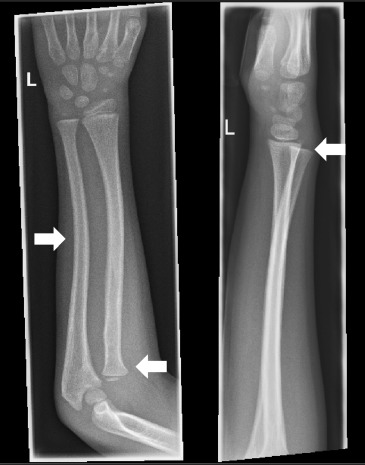A 7-year-old boy attended the emergency department after falling from a climbing frame onto his outstretched left wrist. On examination, there was mild swelling to the left elbow and tenderness to the antecubital fossa. There was also tenderness diffusely to the distal ulnar and radius. There was no neurovascular deficit. Radiographs revealed a plastic deformation fracture of the left radius and ulna, with dislocations of the ipsilateral radiocapitellar joint and distal radioulnar joint. A diagnosis of combined Monteggia and Galeazzi-type fractures of the left forearm was made. It is rare to find cases of combined Monteggia and Galeazzi fractures to the same forearm. Furthermore, to our knowledge, ipsilateral plastic deformation Monteggia and Galeazzi-type fractures in children have not been reported in the literature.
Introduction
Forearm fractures represent 40% to 50% of all fractures in children. They generally occur as a result of a fall on an outstretched hand. The eponymous Monteggia fracture-dislocation refers to a fracture of the shaft of the ulna, accompanied by anterior dislocation of the radial head. The Galeazzi fracture is an unstable fracture-dislocation of the forearm that includes a fracture of the shaft of the radius and a dislocation of the distal radioulnar joint.
The incidence of Monteggia fractures has been reported to be 2% to 4% of all forearm fractures. The incidence of Galeazzi fractures has been reported to be lower, ranging from 0.3% to 2.8%.
The classic radiologic appearance of a plastic bowing fracture is bowing curvature of the bone without a cortical break. There are few reports of presentations of ipsilateral Monteggia and Galeazzi fractures in adults and teenagers but none involving a plastic deformation, to our knowledge.
Case Report
A 7-year-old boy attended the emergency department (ED) after falling from a climbing frame onto his outstretched left wrist. The child was approximately 1 m from the ground and fell feet first and then forward on his wrist onto a grassy surface. He complained of pain to his left elbow and left wrist but denied any other injuries. He was otherwise healthy. On examination, there was mild swelling to the left elbow and tenderness to the antecubital fossa. There was also tenderness diffusely to the distal ulnar and radius. There was no neurovascular deficit.
Radiographs revealed a plastic deformation fracture of the left radius and ulna, with dislocation of the radiocapitellar joint and dislocation of the distal radioulnar joint ( Figure 1 ). A diagnosis was made of combined Monteggia and Galeazzi-type plastic fractures of the left forearm.

The patient underwent an attempted closed reduction in the operating room. The elbow was extended at approximately 120 degrees and supinated, and then traction was applied axially at the wrist. However, the radial head was anteriorly dislocated and was not possible to reduce, so an ulnar osteotomy was performed at the apex of the deformity. The radial head was then reduced and an above-elbow cast applied in 120 degrees of flexion at the elbow and full supination.
Eleven weeks postoperatively, repeated radiographs showed a significant gap at the ulnar midshaft, with a degree of delayed union. Five months after the original injury, a second osteotomy was performed with plating ( Figure 2 ). At follow-up, there was no evidence of any functional deficit, and pain was well controlled.

Case Report
A 7-year-old boy attended the emergency department (ED) after falling from a climbing frame onto his outstretched left wrist. The child was approximately 1 m from the ground and fell feet first and then forward on his wrist onto a grassy surface. He complained of pain to his left elbow and left wrist but denied any other injuries. He was otherwise healthy. On examination, there was mild swelling to the left elbow and tenderness to the antecubital fossa. There was also tenderness diffusely to the distal ulnar and radius. There was no neurovascular deficit.
Radiographs revealed a plastic deformation fracture of the left radius and ulna, with dislocation of the radiocapitellar joint and dislocation of the distal radioulnar joint ( Figure 1 ). A diagnosis was made of combined Monteggia and Galeazzi-type plastic fractures of the left forearm.









